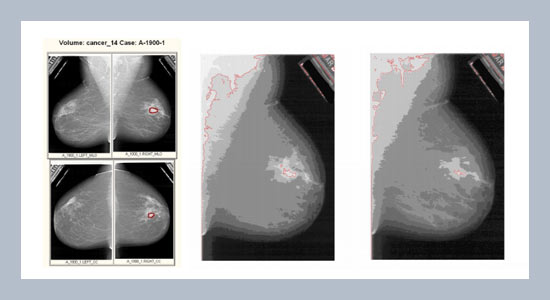Yishuo Huang* Department of Construction Engineering, Chaoyang University of Technology, Wufeng, Taiwan
Download Citation:
|
Download PDF
X-ray mammography provides a non-invasive way of detecting breast cancer early. Detecting breast cancer from mammograms is difficult due to the properties of the image. Mammogram images are images with high-resolution and large size. The low levels of contrast between the cancer cells and normal cells make the automatic and accurate detection of cancer cells difficult. This paper employs two algorithms to solve the above difficulties. Firstly, the given 16-bit mammograms are subjected to a shrinking process to reduce their image sizes. Subsequently, the 16-bit mammograms are converted into 8-bit images employing a pixel-depth conversion algorithm. Without losing generality, the process can significantly reduce the heavy computational burden. Secondly, the multilayer level set approach is applied to the shrunken mammograms to segment a mammogram into several sub-regions, such that each sub-region is homogeneous. The multilayer level set approach has been inspired by the problems proposed by Mumford and Shah. Mumford and Shah proposed the division of an image into a set of homogeneous sub-regions, such that the energy contained in the image can be minimized. Based on this energy minimization, the multilayer level set method implicitly depicts the regional boundaries as several nested level lines. With an increase in the number of iterations and preselected level values, these lines evolve closer to the level boundaries based on the energy minimization criterion. In this paper, the digital database for screening mammography (DDSM), provided by the University of South Florida, is used to evaluate the performance of the proposed algorithms. The experimental results demonstrate that the generated optimal-piecewise-constant approximation can provide the desired segmentation approximation for the given mammogram, and the extracted regional boundaries can effectively assist a physician in locating the breast cancer area.ABSTRACT
Keywords:
Trapezoidal fuzzy number; bi-criteria fixed charge transportation problem; linear ranking function.
Share this article with your colleagues
REFERENCES
ARTICLE INFORMATION
Received:
2011-11-29
Revised:
2012-01-08
Accepted:
2012-01-11
Available Online:
2012-06-01
Huang, Y. 2012. Segmenting mammography to detect breast cancer with employing a multilayer level set approach. International Journal of Applied Science and Engineering, 10, 113–122. https://doi.org/10.6703/IJASE.2012.10(2).113
Cite this article:






